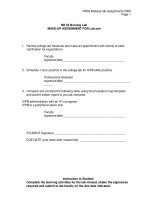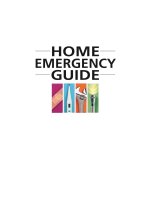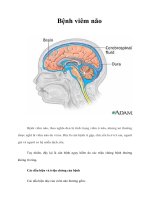Tài liệu Medical-Surgical Nursing Demystified doc
Bạn đang xem bản rút gọn của tài liệu. Xem và tải ngay bản đầy đủ của tài liệu tại đây (2.75 MB, 626 trang )
Medical-Surgical Nursing
Demystified
Demystified Series
Accounting Demystified
Advanced Calculus Demystified
Advanced Physics Demystified
Advanced Statistics Demystified
Algebra Demystified
Alternative Energy Demystified
Anatomy Demystified
asp.net 2.0 Demystified
Astronomy Demystified
Audio Demystified
Biology Demystified
Biotechnology Demystified
Business Calculus Demystified
Business Math Demystified
Business Statistics Demystified
C++ Demystified
Calculus Demystified
Chemistry Demystified
Circuit Analysis Demystified
College Algebra Demystified
Corporate Finance Demystified
Databases Demystified
Data Structures Demystified
Differential Equations Demystified
Digital Electronics Demystified
Earth Science Demystified
Electricity Demystified
Electronics Demystified
Engineering Statistics Demystified
Environmental Science Demystified
Everyday Math Demystified
Fertility Demystified
Financial Planning Demystified
Forensics Demystified
French Demystified
Genetics Demystified
Geometry Demystified
German Demystified
Home Networking Demystified
Investing Demystified
Italian Demystified
Java Demystified
JavaScript Demystified
Lean Six Sigma Demystified
Linear Algebra Demystified
Macroeconomics Demystified
Management Accounting Demystified
Math Proofs Demystified
Math Word Problems Demystified
MATLAB® Demystified
Medical Billing and Coding Demystified
Medical Terminology Demystified
Medical-Surgical Nursing Demystified
Meteorology Demystified
Microbiology Demystified
Microeconomics Demystified
Nanotechnology Demystified
Nurse Management Demystified
OOP Demystified
Options Demystified
Organic Chemistry Demystified
Personal Computing Demystified
Pharmacology Demystified
Physics Demystified
Physiology Demystified
Pre-Algebra Demystified
Precalculus Demystified
Probability Demystified
Project Management Demystified
Psychology Demystified
Quality Management Demystified
Quantum Mechanics Demystified
Real Estate Math Demystified
Relativity Demystified
Robotics Demystified
Sales Management Demystified
Signals and Systems Demystified
Six Sigma Demystified
Spanish Demystified
SQL Demystified
Statics and Dynamics Demystified
Statistics Demystified
Technical Analysis Demystified
Technical Math Demystified
Trigonometry Demystified
UML Demystified
Visual Basic 2005 Demystified
Visual C# 2005 Demystified
Vitamins and Minerals Demystified
XML Demystified
Medical-Surgical Nursing
Demystified
Mary DiGiulio, RN, MSN, APRN
Donna Jackson, RN, MSN, APRN
Jim Keogh
New York Chicago San Francisco Lisbon London Madrid
Mexico City Milan New Delhi San Juan Seoul
Singapore Sydney Toronto
Copyright © 2007 by The McGraw-Hill Companies, Inc. All rights reserved. Manufactured in the United States of America. Except
as permitted under the United States Copyright Act of 1976, no part of this publication may be reproduced or distributed in any form
or by any means, or stored in a database or retrieval system, without the prior written permission of the publisher.
0-07-159543-0
The material in this eBook also appears in the print version of this title: 0-07-149450-2.
All trademarks are trademarks of their respective owners. Rather than put a trademark symbol after every occurrence of a trademarked
name, we use names in an editorial fashion only, and to the benefit of the trademark owner, with no intention of infringement of the
trademark. Where such designations appear in this book, they have been printed with initial caps.
McGraw-Hill eBooks are available at special quantity discounts to use as premiums and sales promotions, or for use in corporate
training programs. For more information, please contact George Hoare, Special Sales, at or (212)
904-4069.
TERMS OF USE
This is a copyrighted work and The McGraw-Hill Companies, Inc. (“McGraw-Hill”) and its licensors reserve all rights in and to the
work. Use of this work is subject to these terms. Except as permitted under the Copyright Act of 1976 and the right to store and
retrieve one copy of the work, you may not decompile, disassemble, reverse engineer, reproduce, modify, create derivative works
based upon, transmit, distribute, disseminate, sell, publish or sublicense the work or any part of it without McGraw-Hill’s prior consent. You may use the work for your own noncommercial and personal use; any other use of the work is strictly prohibited. Your right
to use the work may be terminated if you fail to comply with these terms.
THE WORK IS PROVIDED “AS IS.” McGRAW-HILL AND ITS LICENSORS MAKE NO GUARANTEES OR WARRANTIES
AS TO THE ACCURACY, ADEQUACY OR COMPLETENESS OF OR RESULTS TO BE OBTAINED FROM USING THE
WORK, INCLUDING ANY INFORMATION THAT CAN BE ACCESSED THROUGH THE WORK VIA HYPERLINK OR OTHERWISE, AND EXPRESSLY DISCLAIM ANY WARRANTY, EXPRESS OR IMPLIED, INCLUDING BUT NOT LIMITED TO
IMPLIED WARRANTIES OF MERCHANTABILITY OR FITNESS FOR A PARTICULAR PURPOSE. McGraw-Hill and its licensors do not warrant or guarantee that the functions contained in the work will meet your requirements or that its operation will be
uninterrupted or error free. Neither McGraw-Hill nor its licensors shall be liable to you or anyone else for any inaccuracy, error or
omission, regardless of cause, in the work or for any damages resulting therefrom. McGraw-Hill has no responsibility for the content
of any information accessed through the work. Under no circumstances shall McGraw-Hill and/or its licensors be liable for any
indirect, incidental, special, punitive, consequential or similar damages that result from the use of or inability to use the work, even
if any of them has been advised of the possibility of such damages. This limitation of liability shall apply to any claim or cause
whatsoever whether such claim or cause arises in contract, tort or otherwise.
DOI: 10.1036/0071494502
Professional
Want to learn more?
We hope you enjoy this
McGraw-Hill eBook! If
you’d like more information about this book,
its author, or related books and websites,
please click here.
To the memory of Jim, Rose, and Margot
who always believed in me
To Dave
Who means more than he sometimes knows
To Kathleen and Jacqueline
who have the world in front of them
Mary DiGiulio, RN, MSN
To Ken
Thank you for loving me, believing in me, encouraging me, and running the race
with me. I’m glad I have you.
Love, Donna
Donna Jackson, RN, MSN
This book is dedicated to Anne, Sandy, Joanne, Amber-Leigh Christine, and Shawn,
without whose help and support this book couldn’t have been written.
Jim Keogh
This page intentionally left blank
For more information about this title, click here
CONTENTS
Introduction
CHAPTER 1
xiv
Cardiovascular System
How the Cardiovascular System Works
Just the Facts
Aortic Aneurysm
Angina (Angina Pectoris)
Myocardial Infarction (MI)
Coronary Artery Disease (CAD)
Peripheral Arterial Disease (PAD)
Cardiac Tamponade
Cardiogenic Shock
Cardiomyopathy
Endocarditis
Heart Failure [Congestive Heart Failure (CHF)]
Hypertension (HTN)
Hypovolemic Shock
Myocarditis
Pericarditis
Pulmonary Edema
Raynaud’s Disease
Rheumatic Heart Disease
Thrombophlebitis
Atrial Fibrillation
Asystole
1
3
4
4
7
11
15
18
21
23
26
29
31
35
38
41
42
45
47
49
51
53
56
viii
Medical-Surgical Nursing Demystified
Ventricular Fibrillation
Ventricular Tachycardia
Aortic Insufficiency (AI)
Mitral Insufficiency
Mitral Stenosis
Mitral Valve Prolapse
Tricuspid Insufficiency
Crucial Diagnostic Tests
Quiz
58
59
62
63
65
67
69
71
82
CHAPTER 2
Respiratory System
How the Respiratory System Works
Just the Facts
Acute Respiratory Distress Syndrome (ARDS)
Asbestosis
Asthma
Atelectasis
Bronchiectasis
Bronchitis
Cor Pulmonale
Emphysema
Lung Cancer
Pleural Effusion
Pneumonia
Pneumothorax
Respiratory Acidosis
Tuberculosis (TB)
Acute Respiratory Failure
Pulmonary Embolism
Influenza
Crucial Diagnostic Tests
Quiz
85
86
87
87
91
93
96
99
101
104
107
110
113
115
118
120
122
124
127
130
132
140
CHAPTER 3
Immune System
How the Immune System Works
Just the Facts
Acquired Immunodeficiency Syndrome (AIDS)
Anaphylaxis
Ankylosing Spondylitis
143
144
145
145
147
149
Contents
ix
Kaposi’s Sarcoma(KS)
Lymphoma
Rheumatoid Arthritis
Scleroderma
Mononucleosis
Epstein-Barr Virus/Chronic Fatigue Syndrome
Lyme Disease
Septic Shock
Systemic Lupus Erythematosus (SLE)
Crucial Diagnostic Tests
Quiz
151
153
155
157
159
160
162
163
165
167
171
CHAPTER 4
Hematologic System
How the Hematologic System Works
Just the Facts
Anemia
Aplastic Anemia (Pancytopenia)
Iron Deficiency Anemia
Pernicious Anemia
Disseminated Intravascular Coagulation (DIC)
Hemophilia
Leukemia
Multiple Myeloma
Polycythemia Vera
Sickle Cell Anemia
Deep Vein Thrombosis (DVT)
Idiopathic Thrombocytopenic Purpura (ITP)
Crucial Diagnostic Tests
Quiz
175
176
177
177
179
181
183
185
187
189
192
194
197
199
201
203
206
CHAPTER 5
Nervous System
How the Nervous System Works
Just the Facts
Head Injury
Amyotrophic Lateral Sclerosis (ALS)
Bell’s Palsy
Brain Abscess
Brain Tumor
Cerebral Aneurysm
209
210
212
212
216
218
219
222
225
x
Medical-Surgical Nursing Demystified
Encephalitis
Guillain-Barré Syndrome
Huntington’s Disease (Chorea)
Meningitis
Multiple Sclerosis (MS)
Myasthenia Gravis
Parkinson’s Disease
Spinal Cord Injury
Stroke
Seizure Disorder
Crucial Diagnostic Tests
Quiz
227
230
232
234
237
240
243
246
249
252
255
258
CHAPTER 6
Musculoskeletal System
How the Musculoskeletal System Works
Just the Facts
Carpal Tunnel Syndrome
Fractures
Gout
Osteoarthritis
Osteomyelitis
Osteoporosis
Crucial Diagnostic Tests
Quiz
261
262
263
263
266
268
271
273
275
277
280
CHAPTER 7
Gastrointestinal System
How the Gastrointestinal System Works
Just the Facts
Appendicitis
Cholecystitis
Cirrhosis
Crohn’s Disease
Diverticulitis Disease
Gastroenteritis
Gastroesophageal Reflux Disease (GERD)
Gastrointestinal Bleed
Gastritis
Hepatitis
Hiatal Hernia
283
284
286
286
288
290
294
297
299
301
304
306
308
311
Contents
xi
Intestinal Obstruction and Paralytic Ileus
Pancreatitis
Peritonitis
Peptic Ulcer Disease (PUD)
Ulcerative Colitis
Crucial Diagnostic Tests
Quiz
CHAPTER 8
CHAPTER 9
313
315
317
319
322
324
329
Endocrine System
How the Endocrine System Works
Just the Facts
Hypothyroidism (Myxedema)
Hyperthyroidism (Graves’ Disease)
Simple Goiter
Hypopituitarism
Hyperpituitarism (Acromegaly and Gigantism)
Hyperprolactinemia
Diabetes Insipidus
Syndrome of Inappropriate Antidiuretic Hormone
Secretion (SIADH)
Addison’s Disease
Cushing’s Syndrome
Primary Aldosteronism (Conn’s Syndrome)
Pheochromocytoma
Hypoparathyroidism
Hyperparathyroidism
Diabetes Mellitus
Metabolic Syndrome (Syndrome X/Dysmetabolic
Syndrome)
Crucial Diagnostic Tests
Quiz
331
332
333
333
335
338
340
341
343
345
Genitourinary System
How the Genitourinary System Works
Just the Facts
Benign Prostatic Hypertrophy (BPH)
Bladder Cancer
Acute Glomerulonephritis
Kidney Cancer
373
374
375
375
377
379
381
346
348
349
351
353
354
356
358
363
365
370
xii
Medical-Surgical Nursing Demystified
Kidney Stones
Prostate Cancer
Pyelonephritis
Renal Failure
Testicular Cancer
Urinary Tract Infection
Crucial Diagnostic Tests
Quiz
382
384
386
388
390
392
394
396
CHAPTER 10
Integumentary System
How the Integumentary System Works
Just the Facts
Burns
Dermatitis
Skin Cancers
Cellulitis
Pressure Ulcers
Wounds and Healing
Crucial Diagnostic Tests
Quiz
399
400
401
401
403
405
407
409
411
413
415
CHAPTER 11
Fluids and Electrolytes
How Fluids and Electrolytes Work
Just the Facts
Hyponatremia
Hypernatremia
Hypocalcemia
Hypercalcemia
Hypokalemia
Hyperkalemia
Hypomagnesemia
Hypermagnesemia
Metabolic Acidosis
Metabolic Alkalosis
Hypophosphatemia
Hyperphosphatemia
Dehydration
Crucial Diagnostic Tests
Quiz
419
420
422
422
424
426
428
430
432
434
436
438
440
441
443
444
446
448
Contents
xiii
CHAPTER 12
Mental Health
A Look at Mental Health
Just the Facts
Anxiety
Panic Disorder
Depression
Bipolar Disorder
Schizophrenia
Anorexia Nervosa
Bulimia Nervosa
Delirium
Quiz
451
452
453
453
456
458
461
463
465
467
469
471
CHAPTER 13
Perioperative Care
Perioperative Care
Surgical Classifications
The Preoperative Period
The Intraoperative Period
The Postoperative Period
Just the Facts
Cardiovascular Complications
Respiratory Complications
Infection
Gastrointestinal Complications
Quiz
475
476
476
478
480
482
484
484
486
488
490
492
CHAPTER 14
Women’s Health
The Female Body
Just the Facts
Breast Cancer
Cervical Cancer
Dysmenorrhea
Ectopic Pregnancy
Endometrial Cancer
Fibroids (Leiomyomas)
Infertility
Menopause
Ovarian Cancer
Ovarian Masses, Benign
495
496
497
497
500
502
503
505
507
508
510
512
514
Medical-Surgical Nursing Demystified
xiv
Pelvic Inflammatory Disease (PID)
Trophoblastic Disease
Pregnancy
Labor & Delivery
Postpartum
Rh Incompatibility
Preeclampsia and Eclampsia
Crucial Diagnostic Tests
Quiz
CHAPTER 15
515
517
519
522
524
526
527
529
531
Pain Management
Pain
Just the Facts
Acute Pain
Chronic Pain
Peripheral Neuropathy
Phantom Limb Pain
Substance Use Disorders
Drug Addiction
Crucial Diagnostic Test
535
536
537
537
540
542
544
545
550
553
Quiz
553
Final Exam
557
Answers to Quiz and Exam Questions
577
Glossary
581
Index
589
INTRODUCTION
Every patient knows to seek medical help when his or her aches and pains become
too much to bear, but how does the healthcare provider determine what is wrong and
what to do to restore the patient to good health? The answer depends on the patient’s
signs and symptoms and the results from medical tests. In this book you will learn
to identify these signs and symptoms, interpret the medical test results, and perform
the nursing interventions that will assist in solving or alleviating the patient’s medical problem.
Medical-Surgical Nursing Demystified contains 15 chapters, each providing a
description of a major body system and the diseases and disorders which can affect
that system. The discussion of each disease or disorder is divided into the following
sections:
•
•
•
•
•
•
•
•
What Went Wrong?
Prognosis
Hallmark Signs and Symptoms
Interpreting Test Results
Treatment
Nursing Diagnoses
Nursing Intervention
Crucial Diagnostic Tests
The “What Went Wrong?” section presents a brief description of how the body is
affected when the particular disease or disorder occurs. The “Prognosis” section discusses the possibilities of curing this disease and permanent damage which can
occur. The remaining sections present the information as lists of symptoms, diagnoses, etc. that make it easy for you to learn and that also serve as a useful tool for
later reference.
A Look Inside
Since Medical-Surgical Nursing can be challenging for the beginner, this book was
written to provide an organized, outline approach to learning about major diseases
Copyright © 2007 by The McGraw-Hill Companies, Inc. Click here for terms of use.
xvi
Medical-Surgical Nursing Demystified
and the part the nurse can play in the treatment process. The following paragraphs
provide a thumbnail description of each chapter.
CHAPTER 1 CARDIOVASCULAR SYSTEM
The mere mention of the cardiovascular system brings all sorts of images to mind;
however, these impressions are based on our experience as patients. Healthcare
providers have a different view because they see it as a system that distributes nutrients and oxygen throughout the body and delivers carbon dioxide and metabolic byproducts to various organs for removal from the body. Failure of the cardiovascular
system has a compound effect because it interacts with the body’s other systems
causing a chain reaction of events. Healthcare providers need a thorough understanding of what can go wrong with the cardiovascular system; in this chapter you will
earn to recognize cardiovascular system disorders and to perform the interventions
that can assist in restoring its function.
CHAPTER 2 RESPIRATORY SYSTEM
The respiratory system interacts with cells in the body to exchange oxygen and carbon dioxide, enabling the oxygenation of all cells in the body. In this chapter you
will learn which diseases and disorders can disrupt the respiratory system, how to
recognize these conditions, and what steps you can take to assist in curing the respiratory system problems.
CHAPTER 3 IMMUNE SYSTEM
Remember the last time you experienced a bad cut. The site of the injury became
swollen and red and you might have felt feverish. This happened because your
immune system was trying to heal the wound by attacking the microorganisms that
were invading your body. However, the abilities to fight off disease and to heal a
wound are compromised when the immune system malfunctions. In this chapter you
will learn about immune system disorders and what actions the nurse can perform to
assist in the patient’s recovery,
CHAPTER 4 HEMATOLOGIC SYSTEM
The hematologic system produces and circulates blood cells throughout the body. Any
disorder of this system jeopardizes the functioning of every organ in the body. This
Introduction
xvii
chapter explores the hematologic system and its common disorders and discusses how
to care for patients who experience them.
CHAPTER 5 NERVOUS SYSTEM
The nervous system is the body’s command center that receives impulses and sends
an appropriate response. In this chapter you will learn about the disorders that cause
the malfunctioning of the nervous system and the interventions that mitigate neurological problems.
CHAPTER 6 MUSCULOSKELETAL SYSTEM
The musculoskeletal system is the body’s superstructure that provides strength and
movement. In this chapter you will learn about disorders of the musculoskeletal system and the treatments for restoring its functions.
CHAPTER 7 GASTROINTESTINAL SYSTEM
The body receives nourishment and excretes waste through the gastrointestinal system.
Any disorder of the GI tract might disrupt the body’s ability to store carbohydrates,
lipids, and protein, all of which are used to energize cells. You will learn about these
disorders and what to do about them in this chapter.
CHAPTER 8 ENDOCRINE SYSTEM
The endocrine system is the body’s messenger. It turns on and off messages that direct
the action of organs. Endocrine disorders cause chaos, as messages become misdirected. Endocrine system disorders and what to do about them are presented in this
chapter.
CHAPTER 9 GENITOURINARY SYSTEM
Reproductive organs and the urinary system come from the same embryological
origin, which is why they are combined in the genitourinary system. Disruptions of
the genitourinary system are caused by a variety of disorders, some associated more
with one gender than the other. In this chapter you will learn about these disorders
and the treatments which can correct them.
xviii
Medical-Surgical Nursing Demystified
CHAPTER 10 INTEGUMENTARY SYSTEM
Diseases and disorders of the Integumentary system expose the body to invasion of
viruses, bacteria and other microorganisms because the primary defense—the skin—
is disrupted. In this chapter, you will learn about these diseases and disorders and
discover ways to mitigate them.
CHAPTER 11 FLUIDS AND ELECTROLYTES
Fluids and electrolytes must be in balance for the body to properly function. An
imbalance causes the body to compensate in ways that can have a rippling effect
throughout other systems. In this chapter you will learn about fluids and electrolyte
disorders and how to intervene to restore their balance.
CHAPTER 12 MENTAL HEALTH
Disorders that affect the mind can interfere with daily activities and lead to selfdestructive behaviors. In this chapter, you will learn about mental health disorders, how to
recognize them, and steps that can be taken to minimize their influence on the patient.
CHAPTER 13 PERIOPERATIVE
Surgical intervention is a radical but, at times, necessary treatment for a patient’s
condition. However, surgery can expose the patient to a set of disorders that would
otherwise be avoided if no surgery had occurred. You will learn about these disorders and how to handle them in this chapter.
CHAPTER 14 WOMEN’S HEALTH
The women’s health chapter covers a multitude of conditions that affect women.
Here you will learn how to recognize these conditions, the medication used to treat
them, and the interventions that can mitigate their ill effects on the patient.
CHAPTER 15 PAIN MANAGEMENT
Pain is associated with many disorders and must be successfully managed to reduce its disruptive affect on the patient’s well-being. You will learn the techniques
for managing pain in this chapter.
ABOUT THE AUTHORS
Mary DiGiulio is an Adult Nurse Practitioner on the faculty in the School of Nursing at
UMDNJ in Newark, NJ and in practice in Teaneck, NJ. She has taught nursing at the
graduate, baccalaureate and pre-licensure levels and presented for RN and PN review
courses and nurse refresher courses.
Donna Jackson is an Adult Nurse Practitioner currently in practice in Teaneck, NJ. She
is on the Advisory Board of the nursing program at Saint Peter’s College in Jersey City,
NJ. She has taught nursing courses at the graduate, baccalaureate and pre-licensure levels.
Jim Keogh is on the faculty of Saint Peter’s College in Jersey City and New York
University. He is the author of more than 70 books including Pharmacology Demystified,
Microbiology Demystified, Nurse Management Demystified, Medical Billing and Coding
Demystified, and Charting Demystified.
ACKNOWLEDGMENTS
Mary, Donna, and Jim are indebted to the dedication and work of Judy Bass, Maureen B.
Walker, Pamela A. Pelton, Joanna V. Pomeranz, Nancy W. Dimitry, Gabriella Kadar, Don
Pomeranz, and Don Dimitry who made this book possible.Ihanks to my nephew Tim
Boutelle, a student at the University of Chicago. He spent many hours helping me proofread the manuscript, and he offered insights and suggestions from the point of view of
Copyright © 2007 by The McGraw-Hill Companies, Inc. Click here for terms of use.
the intended audience.
This page intentionally left blank
CHAP TER 1
Cardiovascular System
aorta ascendens
v. cava superior
a. coronaria dextra
a. pulmonalis
a. coronaria sinistra
v. cordis magna
Superior Vena Cava
Arch of the Aorta
Right Atrium
Inferior Vena Cava
Tricuspid Valve
Right Ventricle
Ventricular Septum
Copyright © 2007 by The McGraw-Hill Companies, Inc. Click here for terms of use.
Pulmonary Trunk
Left Atrium
Pulmonary Vein
Mitral Valve
Papillary Muscle
Left Ventricle
Medical-Surgical Nursing Demystified
2
Learning Objectives
1
2
3
4
5
6
7
8
9
10
11
12
13
Aortic aneurysm
Angina (Angina pectoris)
Myocardial infarction (MI)
Coronary artery disease
(CAD)
Peripheral arterial disease
(PAD)
Cardiac tamponade
Cardiogenic shock
Cardiomyopathy
Endocarditis
Heart failure [Congestive heart
failure (CHF)]
Hypertension (HTN)
Hypovolemic shock
Myocarditis
14
15
16
17
18
19
20
21
22
23
24
25
26
27
Pericarditis
Pulmonary edema
Raynaud’s disease
Rheumatic heart disease
Thrombophlebitis
Atrial fibrillation
Asystole
Ventricular fibrillation
Ventricular tachycardia
Aortic insufficiency (AI)
Mitral insufficiency
Mitral stenosis
Mitral valve prolapse (MVP)
Tricuspid insufficiency
Key Terms
Aneurysm
Angina
Aortic valve
Atherosclerosis
Atria
Atrioventricular (AV) valves
Cholesterol
Diastolic
Embolism
Infarction
Ischemia
Mitral valve
Necrosis
Occlusion
Pericardium
Pulmonic valve
Septal wall
Stenosis
Systolic
Tamponade
Tricuspid valve
Ventricle
CHAPTER 1
Cardiovascular System
3
How the Cardiovascular System Works
The cardiovascular system is responsible for delivery of blood, which carries oxygen and other nutrients, to the tissues of the body. The heart pumps the blood to
the body where it delivers nutrients and oxygen, picks up waste products, and then
returns to the heart.
The heart has four chambers. The upper chambers are the atria; the lower chambers are the ventricles. In the middle, there is a septum, a wall that separates the
right side of the heart from the left side of the heart. Atrioventricular (AV) valves
control the blood flow between the upper and lower chambers of the heart. The tricuspid valve is on the right side, while the mitral valve is on the left side between
the atria and the ventricle. The pulmonic valve controls the flow between the right
ventricle and the pulmonary artery, while the aortic valve controls the flow between
the left ventricle and the aorta.
Unoxygenated blood empties into the right atrium from the systemic circulation
via the inferior vena cava and superior vena cava. As the right atrium contracts, the
tricuspid valve opens, allowing the blood to flow into the right ventricle. With contraction of the right ventricle, the pulmonic valve opens, allowing the unoxygenated
blood to enter the pulmonary artery to go to the lungs to pick up oxygen. Once
oxygenated, the blood returns to the heart via the pulmonary vein and enters the
left atrium. As the left atrium contracts, the mitral valve opens, allowing the blood
to flow into the left ventricle. As the left ventricle contracts, the aortic valve opens,
allowing the blood to flow into the aorta and systemic circulation. The blood will
return to the heart from the lower body via the inferior vena cava and from the
upper body via the super vena cava. The actions on the right side and left side of
the heart happen simultaneously. So when we listen to a normal heartbeat, the
sounds we hear are the sounds of the valves closing. The mitral and tricuspid valves
create the first heart sound (S1), while aortic and pulmonic valves create the second heart sound (S2).
The electrical conduction system of the heart starts at the sino-atrial (SA) node,
which is located in the right atrium. It initiates the heart beat, ranging between 60
to 100 beats per minute, every day, for a lifetime. The electrical current travels
across both atria, then converges on the atrio-ventricular (AV) node, where the current slows, allowing the atria to repolarize. The AV node is located in the superior
portion of the ventricular septum. In the bottom portion are located the right and left
Bundle of His, which is a group of special cardiac muscles that sends an electrical
impulse to the ventricle to begin cardiac contractions. These end in the Purkinje
fibers and spread out through the ventricles. The current passing through these
fibers causes ventricular contraction, forcing the blood from the right ventricle to
the lungs and from the left ventricle to the aorta, and thus, the systemic circulation.









